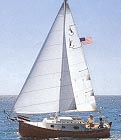 The Comfortable Pocket Yacht
The Comfortable Pocket Yacht 
|
|
|
Trailer Sailing |
Topics
General Maintenance I knew that there were two things that should be done as soon as possible. First, I had noticed some significant gel coat cracks around the port forward stantion. Secondly, the little remaining bottom paint needed to be removed and the entire bottom repainted. I felt that this was a job best left to experts so the boat was turned over to a local yard for this task. Since it was early in the winter, the yard stored the boat for me until they could schedule the work. This saved me about 150 dollars in extra storage costs since the job was not completed until February. I had already decided that the bottom paint would be one of the ablative polymer types. That meant that removing old paint in a future would not be necessary. The yard recommended Micron CSC so I went with their preference. The remaining maintenance would need to wait till spring when I could do the work either on the water or in my driveway. This consisted of: Oiling all interior wood - I used teak oil from a local Danish Furniture shop. I'll need to treat this several times since the wood appeared to be very dry. Cleaning up the interior portholes - This just took elbow grease Constructing exterior porthole trim rings - A number of e-mail exchanges on the Com-Pac discussion exchange had commented on the unfinished appearance of the exterior portholes. While I was able to locate the manufacturer of a bronze trim ring, I found that the portholes were installed too close to the teak cabin rail for this to be viable. Therefore, I made a trim ring from Oak lumber to fit each of the four portholes. These were treated with three coats of Cetol marine, two coats of Cetol gloss, and then attached with silicone caulk. Installing Sail Tell-Tales - As Bruce Bingham points out in his Sailor's Sketchbook, a set of tell-tales on the jib can really help in getting the most out of all available wind. The tell-tales are available for a few dollars at West Marine and take just a few minutes to install. Replacing the in mast wires for the steaming light - These wires had chafed to show bare conductor. This was due to a failed grommet on the mast. I replaced the wire, grommet, and bulb as part of the routine maintenance prior to launch. Refinishing all exterior wood with CETOL marine and CETOL gloss - Some of the reading I had done indicated that the exterior teak on boats should be protected against the sun's ultraviolet rays as well as the elements. Other's maintained that the teak should be left alone to weather to a silver gray color naturally. I preferred the former choice and set out to refinish all exterior wood. While a clear varnish would seem to offer the best looking protection, I chose a combination of Cetol marine and Cetol gloss. Cetol treatment is said to result in an orange cast to the teak. I do not find this to be objectionable and Cetol treatment does not require sanding between coats. My refinishing treatment was therefore:
Installing Spreader Boots - There were no boots left when I purchased the boat. This minor expense would save much wear on the sails. A full set of common hand tools that is permanently on the boat. These tools are in a plastic case that holds each item in a fixed location. This set includes metric and standard sizes of sockets, wrenches, and various types of screw drivers as well as hex key wrenches. This tool box includes a drawer with dividers that I have stocked with a selection of commonly used stainless steel screws, cotter pins, bolts, and nuts. A pocket sized butane torch with torch, solder tip, and hot knife blade accessory (Benz-O-Matic Mini Torch). The torch is vital in repairing electrical soldered connections such as the coaxial plugs. However, the hot knife blade is FANTASTIC at cutting various synthetic lines to size. The cut produced with this accessory is smooth with no unraveling of the line. At about $19 in the hardware store, this device should be on every boat. This page was last updated: 09/14/00 05:11:14 PM |
|
Copyright © 1998-2000 Jobst Vandrey |